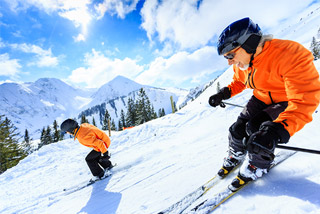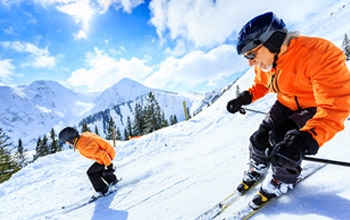 Skiing has always been one of my favorite sports. I grew up skiing in Michigan and it’s been something I’ve continued to be passionate about my entire life. Now, that my own kids are old enough to ski with me I’ve started thinking a lot more about safety and preparation.
Skiing has always been one of my favorite sports. I grew up skiing in Michigan and it’s been something I’ve continued to be passionate about my entire life. Now, that my own kids are old enough to ski with me I’ve started thinking a lot more about safety and preparation.
The exciting and liberating adrenalin rush experienced when skiing down a snow-covered mountain slope at high speeds is matched by few other sporting activities. But this exhilaration does come at a cost. Your lower extremities bear the brunt of the repeated turning and twisting movements, and without proper training or conditioning you could be setting yourself up for injury. Here are a few tips for staying safe on the slopes.
Correct Knee Positioning: The “dropping inwards” of the knees while skiing causes malalignment resulting in inflammation and pain around your kneecap region. To correct the improper movement pattern, stand with your feet parallel and hip-width apart in the skiing position. Now bend your knees ensuring the center of your kneecap is always directly above your 2nd and 3rd toes. Do 20-30 repetitions 2-3 times a day. This exercise will help maintain leg symmetry while skiing.
Correct Hip Positioning: Excessive bending at the hips or “sitting down” too much while skiing makes it harder for your quadriceps muscles to work in efficient manner resulting in excessive strain on the joints and tendons. To prevent this from occurring, practice squatting keeping your weight on the front of your feet during the movement. Do 20-30 repetitions 2-3 times a day. This exercise will help keep your hips in the correct position when skiing.
Use Well-Fitting Equipment and Protective Gear: Make sure the ski boots and other equipment you buy or rent fits you well and the bindings are properly adjusted. Essentials include helmets, goggles, gloves, and layers of clothing to keep you warm.
Get Proper Training: Receiving proper training by a certified instructor will greatly reduce your risk of injury. Even experienced skiers will benefit from polishing up their skills every now and then.
Know Your Limits: Only choose ski trails that are appropriate for your skill level, and don’t go off trail. Most trails will be marked as to what level they are appropriate for. Also, skiing burns a lot of energy. There is no need to try and get in a final run if you are feeling tired and risk injury. It’s best to quit while you’re ahead and come back to ski another day.
Dr. Frisch is a specialist orthopedic surgeon focusing on minimally invasive hip and knee joint replacement.. He believes in creating a very personalized experience with the highest level of service. For all appointments & inquiries, please contact our offices located in Rochester and River District, MI.








